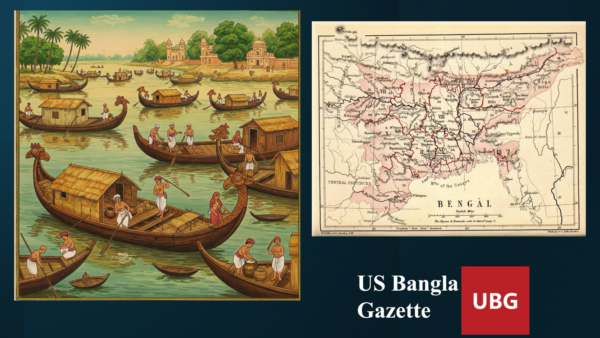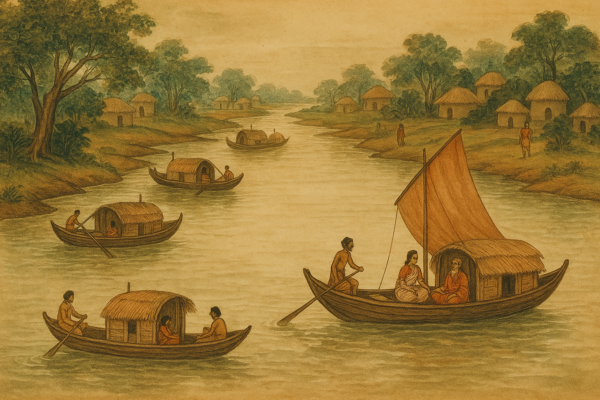The 10th-Century Egalitarian Society of Bengal: A Hidden History

Historically, societies have followed a familiar trajectory: tribal organization gave way to feudal hierarchies, which then transitioned into modern capitalist or socialist states. However, there are rare and often overlooked cases where societies functioned outside this pattern. One such case, buried under centuries of imposed narratives, is Bengal—a region that, before the 11th century, may have been one of the world’s most egalitarian societies.
A Unique Absence of Hierarchy
One of the most striking aspects of Bengal’s early history is the absence of a ruling elite or feudal aristocracy. Unlike other regions of the Indian subcontinent and beyond, Bengal did not seem to produce a sustained native ruling class that resisted foreign takeovers. Invasions by the Turkic-Afghan forces in the 12th century and later the British in the 18th century were met with little or no armed resistance from local elites—a phenomenon unheard of in other major civilizations. Why?
The answer may lie in Bengal’s pre-feudal social structure. Early texts such as the Charyapadas (10th century), the oldest Bengali literature, contain no references to kings, landlords, or warriors. Instead, they reflect a world of boat-dwelling communities, wandering mystics, and decentralized, self-sufficient groups. If a hierarchical elite existed, it left little to no imprint on early literary culture, a stark contrast to neighboring civilizations that glorified their monarchs and warrior classes.

A Prosperous Region Without an Aristocracy
Despite the absence of feudal structures, Bengal was one of the wealthiest regions in the world during the medieval period. Its agricultural abundance and trade networks were unrivaled, yet this economic prosperity did not seem to translate into the emergence of a rigid aristocracy. Unlike in Europe, China, or the Mughal heartlands, wealth in Bengal did not appear to be concentrated in the hands of a few influential families—at least, not until foreign powers imposed new governance models.
This suggests that Bengal’s economic system may have been community-driven rather than aristocratically controlled. Trade, farming, and local governance likely functioned on a decentralized model that was uniquely resistant to the formation of an elite ruling class.
The Mysterious Disappearance of Bengal’s Egalitarian System
What would have happened if Bengal had been an egalitarian society for much of its early history? The first significant shift occurred with the Turkic and Afghan invasions in the 12th century, which introduced a Persian-influenced aristocracy that disrupted the native socio-economic structure. Over the following centuries, Bengal’s original system was further eroded by the Mughal Empire and, later, the British colonial administration, which imposed a rigid landowning class (zamindari system) with no historical precedent in Bengal.
When Bengal entered the modern era, its unique past had been completely erased from mainstream narratives. The feudal and colonial histories imposed by external rulers became the official version of Bengal’s history, and the idea of a once-thriving egalitarian society was forgotten.
Implications for Global History
Bengal’s lost egalitarianism could challenge many dominant assumptions in anthropology and political science if adequately studied. The prevailing belief that all large societies must develop hierarchical structures could be fundamentally flawed. Bengal’s case suggests that an alternative model—a prosperous, large-scale, non-hierarchical society—was possible and existed for centuries before external forces dismantled it.
Understanding this forgotten history chapter could inspire new socio-economic models and political theories. It could provide insights into how decentralized communities can thrive without the need for feudalism or authoritarian rule. In an age where societies are increasingly questioning the sustainability of capitalism and centralized governance, Bengal’s past may hold the key to new possibilities.
Call for International Research
The near-complete erasure of Bengal’s unique past calls for urgent scholarly attention. International researchers must work alongside local historians to recover lost records, analyze early texts with fresh perspectives, and explore archaeological sites for evidence of decentralized social structures.
Uncovering the hidden truths about Bengal’s past may rewrite the region’s history and contribute to a broader understanding of human civilization.
The time has come to bring Bengal’s lost egalitarianism into the global discourse.







